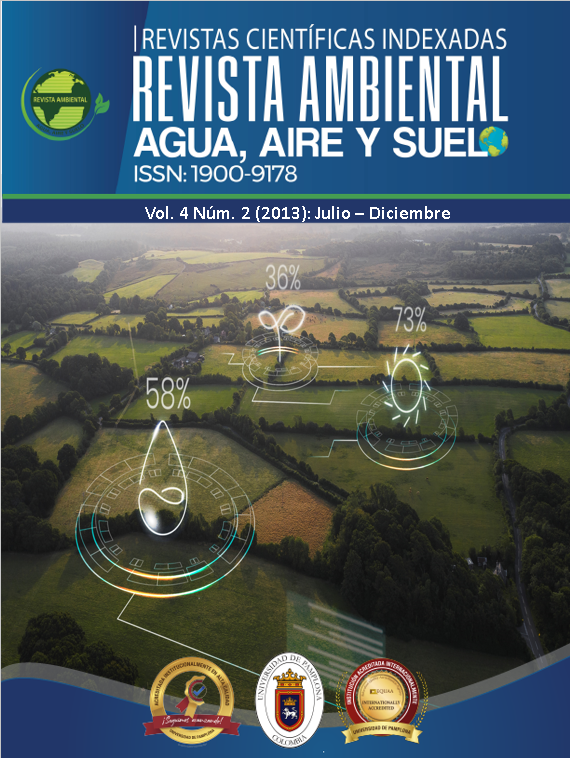Floristic composition and structure of the high Andean scrubland in the Pamplonita River basin
DOI:
https://doi.org/10.24054/aaas.v4i2.2029Keywords:
Diversidad, riqueza, Matorral, estructura, composición florística, Selva altoandinaAbstract
The floristic and structural composition data of the scrubland carried out between 2011 and 2012 in the Upper Pamplonita River Basin,
in the strategic area “Reserva el Volcán” in the Alto Grande district of the municipality of Pamplona, will be established between
3108 and 3031 meters above sea level with a slope of 47.32° from the horizontal and coordinates N 07°20“ ´¨50.8 ”W 72°40´4 “4.2”. The
structural analysis allowed the vegetation to be differentiated into the shrub layer, with an average height of 3.62 m and 28 woody species. The IVI values are for Miconia elaeoides (52.43), Miconia ligustrina (49.21), Gynoxys lindenii (24.25), Hypericum phellos (18.07); the highest IPF values are for Miconia ligustrina (84.24) and Miconia elaeoides (55.73). In terms of richness, 367
individuals, 49 plant species, 46 genera, and 36 families were recorded; the most diverse family with 13 genera was the Asteraceae family, followed by 10
genera of Melastomataceae, Rubiaceae, Ericaceae, Araliaceae, and Dryopteridaceae with 3 genera. The scrub is dominated by
individuals of the species Miconia Ligustrina, Miconia Elaeoides, Gynoxis lindenii, Hypericum phellos, Viburnum triphyllum, Alnus
acuminata, Myrsine coriaceae, Gaultheria sp, Miconia mesmeana, Chaetolepis sp. Baccharis prunifolia, and Lepechinia conferta.
Downloads
References
Ashby, W. C. (1972). Distance measurements in vegetation study. Ecology, 53(5), 980-981.
Barkman, J. J. (1979). The investigation of vegetation texture and structure. En M. J. Werger (Ed.), The study of vegetation (pp. 123-160). Junk, The Hague-Boston.
Briceño, B., & Morillo, G. (2009). Bromeliaceae de los páramos y subpáramos andinos venezolanos. Acta Botanica Venezuelica, 32(1), 179-224.
Connell, J. H., & Slatyer, R. O. (1977). Mechanisms of succession in natural communities and their role in community stability and organization. The American Naturalist, 111(982), 1119-1144.
Fajardo, J. C. (2005). Guía técnica para la restauración ecológica de áreas afectadas por la expansión agropecuaria en el Distrito Capital. Jardín Botánico de Bogotá José Celestino Mutis.
Murcia, R. M. A. (2010). Productividad primaria neta del bosque alto andino en la cuenca del río Pamplonita (Norte de Santander, Colombia): Sucesión regenerativa del bosque alto andino (Tesis doctoral).
Rangel, C. J. O., & Lozano, G. (1986). Un perfil de vegetación entre La Plata (Huila) y el volcán del Puracé. Caldasia, 14(68-70), 503-547.
Rangel, C. J. O., & Velázquez, A. (1997). Métodos de estudio de la vegetación. En Colombia Diversidad Biótica II: Tipos de vegetación en Colombia (pp. 76-80). Universidad Nacional de Colombia.
Sánchez, J., Pérez, M., & Rodríguez, L. (2007). Restauración ecológica de la selva altoandina en la cuenca alta del río Pamplonita. Universidad de Pamplona & COLCIENCIAS.
Vargas, O. (2007). Guía metodológica para la restauración ecológica del bosque altoandino. Grupo de Restauración Ecológica, Universidad Nacional de Colombia.
Downloads
Published
Issue
Section
License
Copyright (c) 2022 REVISTA AMBIENTAL AGUA, AIRE Y SUELO

This work is licensed under a Creative Commons Attribution-NonCommercial 4.0 International License.










